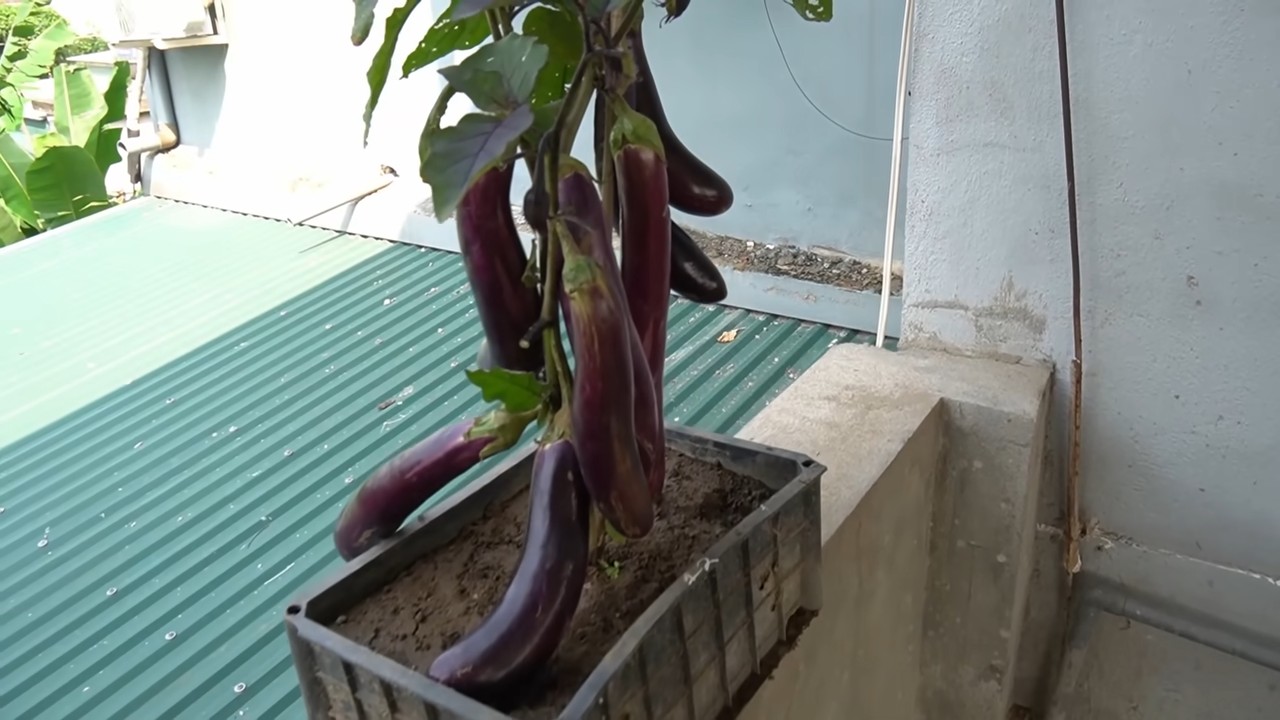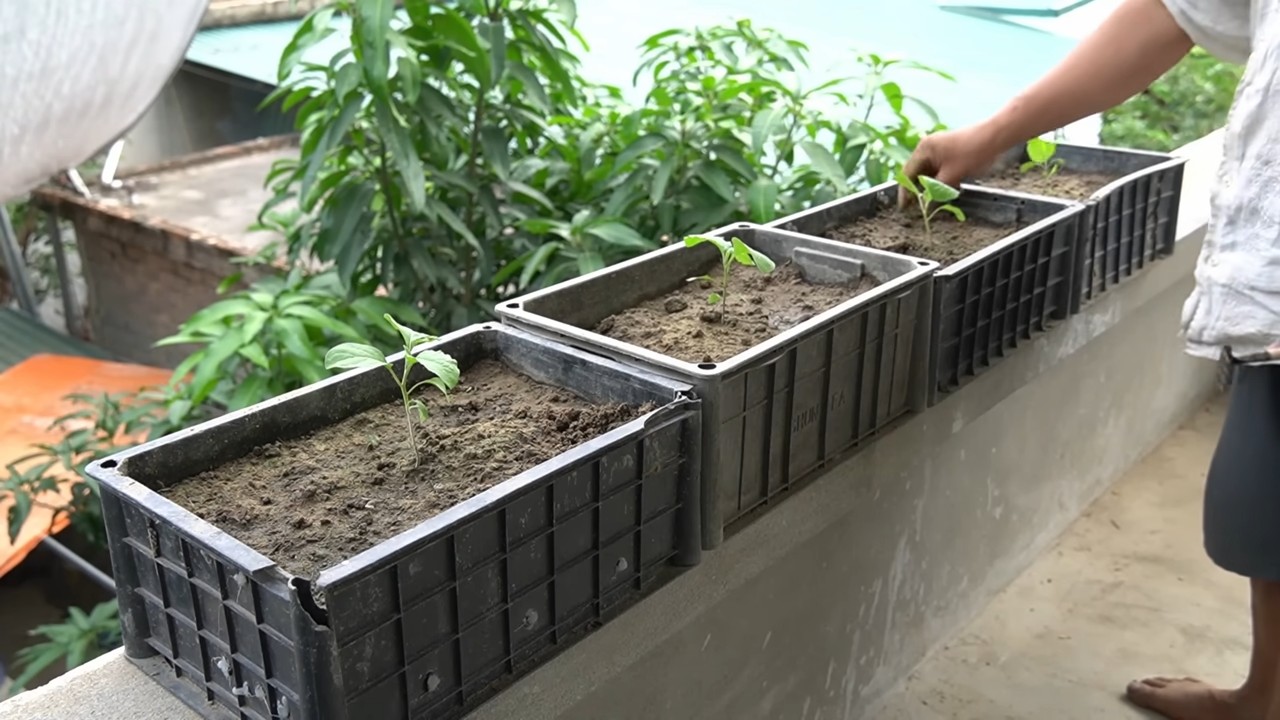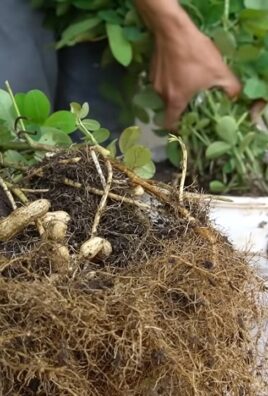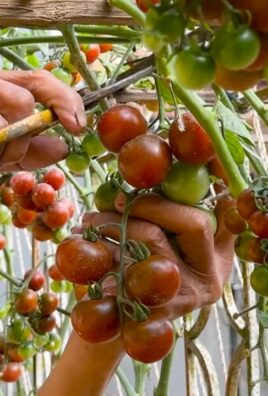Bucket Gardening Eggplants: Imagine harvesting plump, glossy eggplants right from your own backyard, even if you don’t have a sprawling garden! That’s the magic of bucket gardening, and today, I’m going to share some simple DIY tricks to make growing eggplants in buckets a breeze.
Eggplants, with their rich history tracing back to ancient Asia, have been cultivated for centuries. They’re not just delicious; they’re also packed with nutrients. But let’s face it, traditional gardening can be intimidating and time-consuming. That’s where bucket gardening comes in as a game-changer. It’s perfect for apartment dwellers, those with limited space, or anyone who wants a low-maintenance way to enjoy fresh, homegrown produce.
Why do you need these DIY tricks? Well, growing eggplants in buckets isn’t quite the same as planting them in the ground. You need to consider factors like drainage, soil composition, and sunlight exposure. Without the right knowledge, you might end up with stunted plants or a disappointing harvest. But don’t worry, I’ve got you covered! I’ll walk you through everything from choosing the right bucket to providing the perfect nutrients, ensuring your bucket gardening eggplants adventure is a resounding success. Get ready to roll up your sleeves and transform your balcony or patio into a thriving eggplant oasis!

DIY Bucket Gardening: Grow Eggplants Like a Pro!
Hey there, fellow gardening enthusiasts! I’m so excited to share my tried-and-true method for growing delicious, plump eggplants right in buckets. Forget sprawling gardens – this is perfect for patios, balconies, or even just maximizing space in your existing garden. Trust me, with a little love and these simple steps, you’ll be harvesting your own eggplants in no time!
Why Bucket Gardening for Eggplants?
Before we dive in, let’s talk about why bucket gardening is fantastic for eggplants:
* Space-Saving: Ideal for small spaces like apartments, balconies, or patios.
* Portability: Easily move your eggplants to chase the sun or protect them from harsh weather.
* Controlled Environment: Better control over soil quality, watering, and pest management.
* Reduced Weeding: Less weeding compared to traditional in-ground gardening.
* Warmer Soil: Buckets can warm up faster than the ground, promoting earlier growth.
What You’ll Need: The Essential Supplies
Okay, let’s gather our supplies. Here’s what you’ll need to get started:
* Buckets: 5-gallon buckets are the sweet spot. Make sure they’re food-grade plastic if possible. You can often find these at hardware stores or even repurpose old ones (just clean them thoroughly!).
* Eggplant Seedlings: Choose a variety that suits your climate and taste. I personally love ‘Black Beauty’ for its classic flavor and reliable production. You can start from seeds indoors, but buying seedlings from a local nursery will save you time and effort.
* Potting Mix: Don’t skimp on this! Use a high-quality potting mix specifically formulated for containers. Avoid garden soil, as it can compact and drain poorly in buckets.
* Drainage Material: Gravel, pebbles, or even broken pottery shards for the bottom of the buckets. This ensures proper drainage and prevents root rot.
* Fertilizer: A balanced slow-release fertilizer (10-10-10 or similar) and a liquid fertilizer for supplemental feeding.
* Watering Can or Hose: For, well, watering!
* Trowel or Small Shovel: For transplanting your seedlings.
* Optional:
* Stakes or Cages: Eggplants can get quite heavy with fruit, so staking or caging them will provide support and prevent branches from breaking.
* Mulch: Organic mulch like straw or wood chips helps retain moisture, suppress weeds, and regulate soil temperature.
* Gardening Gloves: To keep your hands clean and protected.
Step-by-Step Guide: Planting Your Eggplants
Alright, let’s get our hands dirty! Here’s the step-by-step process for planting your eggplant seedlings in buckets:
1. Prepare the Buckets: Drainage is Key
* First, if your buckets don’t already have them, you’ll need to drill drainage holes. I usually drill about 4-5 holes, each about ½ inch in diameter, in the bottom of each bucket. This is crucial to prevent waterlogging, which eggplants absolutely hate.
* Next, add a layer of drainage material (gravel, pebbles, or broken pottery) to the bottom of each bucket. Aim for a layer that’s about 2-3 inches thick. This will help ensure that excess water drains away from the roots.
2. Fill the Buckets with Potting Mix: The Right Foundation
* Now, it’s time to fill the buckets with your high-quality potting mix. Leave about 2-3 inches of space at the top of the bucket. This will make watering easier and prevent soil from splashing out.
* Gently press down on the potting mix to remove any air pockets. You want the soil to be firm but not compacted.
3. Transplant the Seedlings: Handle with Care
* Carefully remove the eggplant seedlings from their nursery pots. Gently loosen the roots with your fingers, being careful not to damage them.
* Dig a hole in the center of each bucket that’s large enough to accommodate the root ball of the seedling.
* Place the seedling in the hole, ensuring that the top of the root ball is level with the surface of the potting mix.
* Fill in the hole with potting mix, gently pressing down around the base of the plant.
4. Water Thoroughly: Give Them a Good Start
* Water the newly planted seedlings thoroughly until water drains out of the drainage holes. This will help settle the soil and ensure that the roots are well-hydrated.
5. Add Fertilizer: Nourishment for Growth
* Incorporate a slow-release fertilizer into the top layer of the potting mix, following the instructions on the fertilizer package. This will provide your eggplants with a steady supply of nutrients throughout the growing season.
6. Mulch (Optional): Extra Protection and Moisture Retention
* If you’re using mulch, spread a layer of organic mulch around the base of the plants, being careful not to cover the stems. This will help retain moisture, suppress weeds, and regulate soil temperature.
7. Stake or Cage (Optional): Support for Heavy Fruit
* If you’re using stakes or cages, install them now to provide support for the plants as they grow and produce fruit. This is especially important for larger eggplant varieties.
Caring for Your Bucket Eggplants: The Secret to a Bountiful Harvest
Now that your eggplants are planted, it’s time to focus on providing them with the care they need to thrive. Here’s what you need to know:
Watering: Consistent Moisture is Key
* Eggplants need consistent moisture, especially during hot weather. Water deeply whenever the top inch of soil feels dry to the touch. Avoid overwatering, as this can lead to root rot.
* Water in the morning to allow the foliage to dry before nightfall, which can help prevent fungal diseases.
Fertilizing: Regular Feeding for Optimal Growth
* In addition to the slow-release fertilizer you added at planting time, you’ll need to supplement with a liquid fertilizer every 2-3 weeks. Use a balanced fertilizer or one specifically formulated for tomatoes and vegetables.
* Follow the instructions on the fertilizer package carefully to avoid over-fertilizing, which can burn the roots.
Sunlight: Eggplants Love the Sun
* Eggplants need at least 6-8 hours of direct sunlight per day to produce a good crop of fruit. Choose a location that receives plenty of sun.
* If you live in a particularly hot climate, you may need to provide some afternoon shade to prevent the plants from getting scorched.
Pest and Disease Control: Stay Vigilant
* Keep an eye out for common eggplant pests like aphids, flea beetles, and spider mites. Treat infestations promptly with insecticidal soap or neem oil.
* Prevent fungal diseases by providing good air circulation, avoiding overhead watering, and removing any diseased leaves.
Pruning: Encourage Bushier Growth
* Pruning can help encourage bushier growth and improve air circulation. Remove any suckers (small shoots that grow from the base of the plant) and any yellowing or damaged leaves.
Pollination: Help Nature Along
* Eggplants are self-pollinating, but you can help them along by gently shaking the plants or using a small paintbrush to transfer pollen from one flower to another. This is especially helpful in hot, humid weather when pollination can be less efficient.
Harvesting Your Eggplants: The Moment of Truth!
Finally, the moment you’ve been waiting for – harvesting your eggplants!
* Eggplants are typically ready to harvest about 60-80 days after transplanting, depending on the variety.
* Look for fruits that are firm, glossy, and have a deep, rich color. The skin should be smooth and unblemished.
* Use a sharp knife or pruning shears to cut the eggplant from the plant, leaving about an inch of stem attached.
* Harvest eggplants regularly to encourage continued production. Overripe eggplants can become bitter and seedy.
Troubleshooting: Common Problems and Solutions
Even with the best care, you might encounter some challenges along the way. Here are some common problems and how to address them:
* Yellowing Leaves: Could be a sign of overwatering, nutrient deficiency, or pest infestation. Adjust watering, fertilize, and inspect for pests.
* Blossom Drop: Often caused by temperature stress (too hot or too cold) or poor pollination. Provide shade during hot weather and hand-pollinate if necessary.
* Small or Misshapen Fruit: Could be due to insufficient sunlight, poor pollination, or nutrient deficiency. Ensure adequate sunlight, hand-pollinate, and fertilize regularly.
* Pest Infestations: Treat promptly with insecticidal soap or neem oil.
* Fungal Diseases: Provide good air circulation, avoid overhead watering, and remove

Conclusion
So, there you have it! Transforming a simple bucket into a thriving eggplant haven is not only achievable but also incredibly rewarding. We’ve walked you through the process, highlighting the ease and cost-effectiveness of this method. But why is bucket gardening eggplants a must-try?
Firstly, it offers unparalleled control over your growing environment. You dictate the soil composition, ensuring your eggplants receive the precise nutrients they need. This is particularly beneficial if you have poor soil quality in your yard or live in an area with limited space. Container gardening allows you to move your plants to chase the sun or shelter them from harsh weather conditions, giving them the best possible chance to flourish.
Secondly, it’s a fantastic way to extend your growing season. By starting your eggplants indoors in buckets, you can get a head start on the season and enjoy a longer harvest. And as the weather cools down in the fall, you can easily bring your buckets indoors to protect your plants from frost, potentially extending your harvest even further.
Thirdly, it’s incredibly accessible. You don’t need a large garden or specialized equipment to grow your own delicious eggplants. All you need are a few buckets, some good quality potting mix, and a sunny spot. This makes it a perfect option for apartment dwellers, urban gardeners, or anyone who wants to enjoy fresh, homegrown produce without a lot of hassle.
But don’t stop there! Experiment with different eggplant varieties to find your favorites. Try adding companion plants like basil or marigolds to your buckets to deter pests and attract pollinators. You can also explore different fertilization methods, such as using compost tea or organic fertilizers, to boost your eggplant’s growth and yield.
Consider these variations to personalize your bucket gardening experience:
* Vertical Gardening: Stack your buckets vertically to create a stunning and space-saving eggplant tower.
* Self-Watering Buckets: Modify your buckets to create a self-watering system, reducing the need for frequent watering.
* Colored Buckets: Use different colored buckets to add a touch of personality to your garden. Some studies suggest that certain colors can even attract or repel insects.
We are confident that you’ll find bucket gardening eggplants to be a fun, fulfilling, and delicious experience. The satisfaction of harvesting your own homegrown eggplants is truly unmatched.
So, grab your buckets, get your hands dirty, and start growing! We encourage you to try this DIY trick and share your experiences with us. Let us know what varieties you’re growing, what challenges you’ve faced, and what successes you’ve achieved. Share your photos and tips in the comments below. We can’t wait to see your bucket gardens thrive! Happy gardening!
Frequently Asked Questions (FAQ)
What size bucket is best for growing eggplants?
The ideal bucket size for growing eggplants is at least 5 gallons, but 10-gallon buckets are even better. Larger buckets provide more room for the roots to grow and help retain moisture, which is crucial for healthy eggplant development. Smaller buckets may restrict root growth and lead to stunted plants and reduced yields. Ensure the bucket has drainage holes to prevent waterlogging.
What type of soil should I use for bucket gardening eggplants?
Use a high-quality potting mix specifically formulated for container gardening. Avoid using garden soil, as it can become compacted in containers and doesn’t provide adequate drainage. A good potting mix should be lightweight, well-draining, and rich in organic matter. You can also amend your potting mix with compost or other organic materials to improve its fertility and water-holding capacity. A slightly acidic pH (around 6.0 to 6.8) is ideal for eggplants.
How often should I water my eggplants in buckets?
Water your eggplants regularly, especially during hot and dry weather. The frequency of watering will depend on the size of the bucket, the type of potting mix, and the weather conditions. Check the soil moisture regularly by sticking your finger into the soil. If the top inch of soil feels dry, it’s time to water. Water deeply until water drains out of the drainage holes. Avoid overwatering, as this can lead to root rot.
How much sunlight do eggplants need when grown in buckets?
Eggplants need at least 6-8 hours of direct sunlight per day to thrive. Choose a sunny location for your bucket garden where your eggplants will receive plenty of sunlight. If you live in a very hot climate, you may need to provide some afternoon shade to prevent the plants from overheating. If you don’t have enough sunlight, you can supplement with grow lights.
What kind of fertilizer should I use for bucket gardening eggplants?
Eggplants are heavy feeders and require regular fertilization to produce abundant fruit. Use a balanced fertilizer with a higher phosphorus content to promote flowering and fruiting. You can use a slow-release fertilizer at planting time or a liquid fertilizer every 2-3 weeks during the growing season. Organic fertilizers, such as compost tea or fish emulsion, are also excellent options. Follow the instructions on the fertilizer label carefully to avoid over-fertilizing.
How do I prevent pests and diseases in my bucket gardening eggplants?
Regularly inspect your eggplants for signs of pests and diseases. Common pests that affect eggplants include aphids, flea beetles, and spider mites. You can control these pests with insecticidal soap, neem oil, or by handpicking them off the plants. Diseases that can affect eggplants include fungal diseases like early blight and verticillium wilt. Prevent these diseases by providing good air circulation, avoiding overhead watering, and using disease-resistant varieties.
Can I move my bucket gardening eggplants?
Yes, one of the advantages of bucket gardening is that you can easily move your plants. This is especially helpful if you need to protect your plants from frost, extreme heat, or strong winds. Make sure to lift the buckets carefully to avoid damaging the plants. If the buckets are too heavy to lift, you can use a dolly or hand truck to move them.
How long does it take for eggplants to produce fruit in buckets?
Eggplants typically take 60-80 days from transplanting to produce mature fruit. The exact time will depend on the variety of eggplant, the growing conditions, and the weather. Be patient and continue to provide your plants with proper care, and you will soon be rewarded with delicious, homegrown eggplants.
What are some good eggplant varieties to grow in buckets?
Many eggplant varieties are well-suited for container gardening. Some popular choices include ‘Black Beauty’, ‘Ichiban’, ‘Fairy Tale’, and ‘Patio Baby’. Choose varieties that are compact and productive in containers. Read the seed packet or plant label to determine the mature size of the plant and choose a bucket that is large enough to accommodate its growth.
How do I know when my eggplants are ready to harvest?
Eggplants are ready to harvest when they are firm, glossy, and have reached their mature size and color. The skin should be smooth and unblemished. Gently press the eggplant with your finger. If it feels firm and slightly yields to pressure, it’s ready to harvest. Use a sharp knife or pruning shears to cut the eggplant from the plant, leaving a short stem attached. Harvest eggplants regularly to encourage continued production.





Leave a Comment